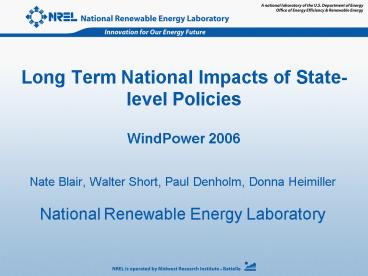Long Term National Impacts of Statelevel Policies WindPower 2006
1 / 21
Title:
Long Term National Impacts of Statelevel Policies WindPower 2006
Description:
What impact will state-level incentives have on wind capacity ... Based on viability of wind resource and other state renewable resources (solar, biomass, etc. ... –
Number of Views:40
Avg rating:3.0/5.0
Title: Long Term National Impacts of Statelevel Policies WindPower 2006
1
Long Term National Impacts of State-level
PoliciesWindPower 2006
- Nate Blair, Walter Short, Paul Denholm, Donna
Heimiller - National Renewable Energy Laboratory
2
Goal of Analysis
- Attempting to answer the following questions
- What impact will state-level incentives have on
wind capacity growth in the near future and the
distant future? - How are state-level policies shaping the
dispersal of wind deployment across the country ? - This effect interacts with dispersal due to
capacity value increase with greater dispersal. - Could higher penalties promote greater compliance
with RPS? And how high should they be?
3
Contents
- Brief Description of the WinDS Model
- Base Case results
- State-Level Policy Impacts
- No State-Level Policy
- Impact of Penalty Level on RPS Compliance
4
WinDS Model(Wind Deployment Systems Model)
- A multi-regional, multi-time-period model of
capacity expansion in the electric sector of the
U.S. - Designed to estimate market potential of wind
energy in the U.S. for the next 20 50 years
under different technology development and policy
scenarios
5
WinDS Regions
6
Wind Resources in WinDS
7
WinDS is Designed to Address the Principal Market
Issues for Wind
- Access to and cost of transmission
- Class 4 close to the load or class 6 far away?
- How much wind can be transmitted on existing
lines? - Will wind penetrate the market if it must cover
the cost of new transmission lines? - Will offshore wind close to seaboard loads
penetrate? - Resource Variability
- How does wind capacity credit change with
penetration? - How do ancillary service requirements increase
with wind market penetration - How much would dispersal of wind sites help?
- Is on-site storage cost effective?
8
General Characteristics of WinDS
- Linear program cost minimization for each of 26
two-year periods from 2000 to 2050 - Sixteen time slices in each year 4 daily and 4
seasons - 4 levels of regions wind supply/demand, power
control areas, NERC areas, Interconnection areas - Existing and new transmission lines
- 5 wind classes (3-7), onshore and offshore
shallow and deep - All major power technologies hydro, gas CT, gas
CC, 4 coal technologies, nuclear, gas/oil steam - Electricity storage capability
9
Base Case Capacity by Wind Class
10
Base Case Generation Fractions
11
Basecase Wind Capacity in 2050
12
Legislation Leaves Modeling Questions
- How long is the final RPS fraction to be
maintained? - What is the penalty for non-compliance with an
RPS? - standard utility enforcement ???
- What RPS fraction is from wind?
- How long will PTCs and ITCs last?
- Frequently Changing Legislation
13
Our Modeling Assumptions for Incentives
- State Incentives based on DSIRE database and
other sources. - If no duration given, assumed incentive lasts
throughout the simulation. - Assumed complete RPS compliance for affected
utilities either by purchasing renewables or
paying the penalty - Munis and coops frequently exempted
- Fraction that must be met by wind determined
exogenously - Based on viability of wind resource and other
state renewable resources (solar, biomass, etc.) - Assumed that RPS requirements can be met by wind
generation transmitted in from other states.
14
State RPS Assumptions
15
State PTC and ITC Assumptions
16
Wind Capacity With W/out State Incentives
(WithW/out RD Improvements)
17
Delta Wind Consumed in 2030 (MWh) (normal state
incentives - no state incentives)
18
Delta Wind Consumed in 2050 (MWh) (normal state
incentives - no state incentives)
19
Increased Penalty Values would increase RPS
compliance
20
Conclusions
- State-level incentives drive a significant
fraction of the early growth in wind
installations. - In the second decade of the 21st century, current
incentives will most likely not continue to be a
primary factor in new wind growth. - Enhanced incentives and the spread of incentives
to new states could continue to spur wind energy
growth. - Higher penalty amounts and enforcement are
critical to reaching expected RPS penetration
levels. - Continued work on including additional
state-level incentives and updating existing
incentives is necessary for more precise
near-term forecasts.
21
Disclaimer and Government License This work
has been authored by Midwest Research Institute
(MRI) under Contract No. DE-AC36-99GO10337 with
the U.S. Department of Energy (the DOE). The
United States Government (the Government)
retains and the publisher, by accepting the work
for publication, acknowledges that the Government
retains a non-exclusive, paid-up, irrevocable,
worldwide license to publish or reproduce the
published form of this work, or allow others to
do so, for Government purposes. Neither MRI,
the DOE, the Government, nor any other agency
thereof, nor any of their employees, makes any
warranty, express or implied, or assumes any
liability or responsibility for the accuracy,
completeness, or usefulness of any information,
apparatus, product, or process disclosed, or
represents that its use would not infringe any
privately owned rights. Reference herein to any
specific commercial product, process, or service
by trade name, trademark, manufacturer, or
otherwise does not constitute or imply its
endorsement, recommendation, or favoring by the
Government or any agency thereof. The views and
opinions of the authors and/or presenters
expressed herein do not necessarily state or
reflect those of MRI, the DOE, the Government, or
any agency thereof.































